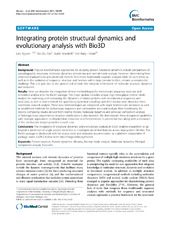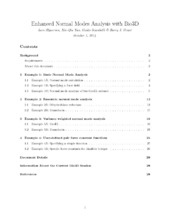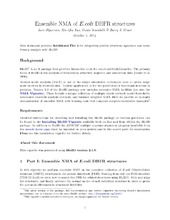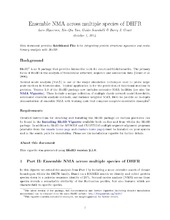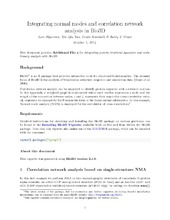| dc.contributor.author | Skjærven, Lars | en_US |
| dc.contributor.author | Yao, Xin-Qiu | en_US |
| dc.contributor.author | Scarabelli, Guido | en_US |
| dc.contributor.author | Grant, Barry J. | en_US |
| dc.date.accessioned | 2015-01-12T13:43:28Z | |
| dc.date.available | 2015-01-12T13:43:28Z | |
| dc.date.issued | 2014-12-10 | eng |
| dc.identifier.issn | 1471-2105 | |
| dc.identifier.uri | https://hdl.handle.net/1956/9113 | |
| dc.description.abstract | Background: Popular bioinformatics approaches for studying protein functional dynamics include comparisons of crystallographic structures, molecular dynamics simulations and normal mode analysis. However, determining how observed displacements and predicted motions from these traditionally separate analyses relate to each other, as well as to the evolution of sequence, structure and function within large protein families, remains a considerable challenge. This is in part due to the general lack of tools that integrate information of molecular structure, dynamics and evolution. Results: Here, we describe the integration of new methodologies for evolutionary sequence, structure and simulation analysis into the Bio3D package. This major update includes unique high-throughput normal mode analysis for examining and contrasting the dynamics of related proteins with non-identical sequences and structures, as well as new methods for quantifying dynamical couplings and their residue-wise dissection from correlation network analysis. These new methodologies are integrated with major biomolecular databases as well as established methods for evolutionary sequence and comparative structural analysis. New functionality for directly comparing results derived from normal modes, molecular dynamics and principal component analysis of heterogeneous experimental structure distributions is also included. We demonstrate these integrated capabilities with example applications to dihydrofolate reductase and heterotrimeric G-protein families along with a discussion of the mechanistic insight provided in each case. Conclusions: The integration of structural dynamics and evolutionary analysis in Bio3D enables researchers to go beyond a prediction of single protein dynamics to investigate dynamical features across large protein families. The Bio3D package is distributed with full source code and extensive documentation as a platform independent R package under a GPL2 license from http://thegrantlab.org/bio3d/. | en_US |
| dc.language.iso | eng | eng |
| dc.publisher | BioMed Central | eng |
| dc.rights | Attribution CC BY | eng |
| dc.rights.uri | http://creativecommons.org/licenses/by/4.0 | eng |
| dc.subject | Protein structure | eng |
| dc.subject | Protein dynamics | eng |
| dc.subject | Allostery | eng |
| dc.subject | Normal mode analysis | eng |
| dc.subject | Molecular dynamics | eng |
| dc.subject | Principal component analysis | eng |
| dc.subject | Evolution | eng |
| dc.title | Integrating protein structural dynamics and evolutionary analysis with Bio3D | en_US |
| dc.type | Peer reviewed | |
| dc.type | Journal article | |
| dc.date.updated | 2015-01-07T17:51:20Z | |
| dc.description.version | publishedVersion | en_US |
| dc.rights.holder | Copyright 2014 Skjærven et al.; licensee BioMed Central | |
| dc.rights.holder | Lars Skjærven et al.; licensee BioMed Central Ltd. | |
| dc.source.articlenumber | 399 | |
| dc.identifier.doi | https://doi.org/10.1186/s12859-014-0399-6 | |
| dc.identifier.cristin | 1193630 | |
| dc.source.journal | BMC Bioinformatics | |
| dc.source.40 | 15 | |
